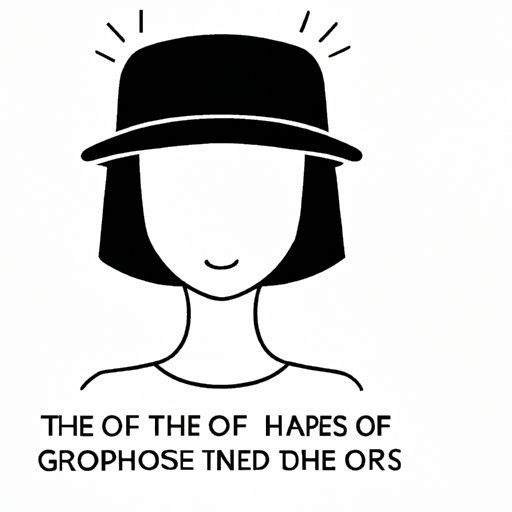
Introduction
One of the most common myths about hair loss is that wearing hats causes baldness. For many people, this myth has been a source of anxiety and worry. In this article, we will explore the science behind this misconception and provide you with the facts you need to keep your hair healthy while wearing hats.
The Bald Truth: Dispelling the Myth That Wearing Hats Causes Baldness
Many people believe that wearing hats for extended periods can suffocate the hair follicles and interrupt the normal growth cycle of the hair, ultimately leading to hair loss. However, there is no scientific evidence to support this claim. Hair loss is a complex process that can involve genetics, diet, stress, and other factors. Wearing a hat for a few hours each day is unlikely to cause significant hair loss.
In fact, many men who wear hats regularly have a full head of hair well into old age. While hats may exacerbate existing hair loss or make receding hairlines more noticeable, they are not the root cause of baldness.

Hats Off to Good Hair: Exploring the Link Between Headwear and Hair Loss
While wearing a hat does not cause hair loss, it can contribute to hair damage and breakage, especially if the hat is tight or made of materials that do not breathe well. Wearing a tight-fitting hat that rubs against the scalp can cause a condition known as traction alopecia, which is hair loss caused by excessive pulling or tension on hair shafts.
Similarly, wearing hats that are too hot or do not allow for proper ventilation can lead to sweating and buildup of sebum, a natural oil produced by the scalp, which can clog hair follicles and lead to inflammation and hair loss. Therefore, it’s important to choose hats made of breathable, lightweight materials that fit well and do not place undue pressure on the scalp.
Covering Up or Covering Baldness? The Science Behind Hat Use and Hair Health
While hats do not cause baldness, they can protect hair from damage caused by the sun, wind, and other environmental factors. Exposure to ultraviolet (UV) radiation is a major cause of hair damage and breakage. Wearing a hat can block up to 98% of UV rays and prevent sunburn, dryness, and brittleness of the hair.
Additionally, wearing a hat can help control hair during humid or tropical climates. High humidity can cause frizz and damage to the hair, while excessive sweating can lead to bacterial buildup and unpleasant odors. A hat can help absorb sweat and keep hair dry and clean.
Therefore, wearing a hat can actually be beneficial for hair health, as long as it’s done in a responsible manner. It’s important to choose a high-quality hat made of breathable, lightweight materials that fit well and allow for proper ventilation.
Busting the Baldness Myth: How to Protect Your Hair While Wearing Hats
If you’re concerned about the effects of wearing hats on your hair, there are several steps you can take to minimize damage and keep your hair healthy:
- Choose hats made of breathable, lightweight materials such as cotton or linen, especially during hot weather.
- Avoid wearing tight-fitting hats that may rub against your scalp, and opt for hats with adjustable bands or snap closures.
- Wash and dry your hair regularly to prevent buildup of sebum and sweat on the scalp.
- If you have a particularly sensitive scalp, consider wearing a thin, breathable liner under your hat to reduce friction and irritation.
- Consider investing in a hat with a wide brim or UPF (Ultraviolet Protection Factor) rating to provide extra protection from UV radiation.
Hats and Hair Loss: Myths and Facts About This Common Misconception
There are many other myths about hair loss and hats that are important to address. For example, some people believe that wearing hats too often can cause the hair to become greasy or dirty, leading to hair loss. However, there is no scientific evidence to support this claim, and in fact, wearing a hat can help keep hair clean and dry.
Another common myth is that baldness is only caused by genetics and that there is nothing you can do to prevent it. While genetics play a significant role in hair loss, environmental factors such as stress, diet, and exposure to UV radiation can also contribute to hair damage and loss. Therefore, taking steps to protect your hair from these factors is important for maintaining healthy hair throughout your lifetime.
To Hat or Not to Hat: Debunking the Idea That Wearing Headwear Causes Balding
Wearing hats does not cause hair loss. It’s a common misconception that has been perpetuated for generations. In fact, wearing a hat can be beneficial for hair health, as it can protect hair from damage caused by the sun and other environmental factors.
If you’re concerned about the effects of wearing hats on your hair, there are several steps you can take to minimize damage and keep your hair healthy. By choosing hats made of breathable, lightweight materials, avoiding tight-fitting hats, and washing your hair regularly, you can enjoy the style and functionality of hats without worrying about the effects on your hair.
Conclusion
In conclusion, wearing hats does not cause baldness. The belief that it does is a stubborn myth that has been perpetuated for generations. While wearing a hat can contribute to hair damage and breakage, it can also protect hair from damage caused by the sun and other environmental factors.
To keep your hair healthy while wearing hats, it’s important to choose hats made of breathable, lightweight materials, wash your hair regularly, and avoid tight-fitting hats that may rub against the scalp. By following these tips, you can enjoy the benefits of hats without worrying about any adverse effects on your hair.




